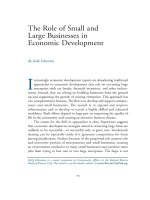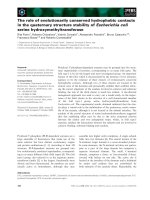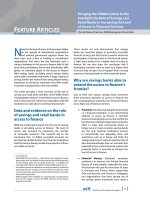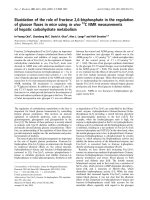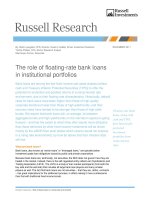the role of urban land readjustment institution in urban development
Bạn đang xem bản rút gọn của tài liệu. Xem và tải ngay bản đầy đủ của tài liệu tại đây (3.52 MB, 18 trang )
Paper 4: The Role of Urban Land Readjustment Institution in
Urban Development and its Challenges
Chien-yuan Chen
Urban Land Readjustment (ULRA) is deemed a good alternative form to complete the
urban development and to provide necessary public facilities. ULRA is assumed to be
better than eminent domain or compulsory purchase institution by which it does not
need government budget and causes less conflicts. ULRA theoretically demonstrates
how government can recapture the spillover effect of public goods from landowners and
therefore sponsors the necessary neighborhood public facilities by associated landowners.
Taiwan is indeed a country where widely adopted ULRA successfully to accomplish the
Taiwan’s urbanization. This chapter will unveil how ULRA is introduced, designed and
applied in Taiwan.
Moreover, Lincoln institute ever published a book in 2007, Analysing Land Readjustment,
(Hong and Needham, 2007) concluded that the ULRA is worth to study further and
considered to be applied in countries such as United states and those not yet conducted.
According to Hong (2007) the successful application of Land readjustment institution has
four key elements. The first one which is a country must uphold the private property rights
regime. Second element is the robust legislation for ULRA. Third is the proper economic
inducement. The fourth is the value of trust and reciprocity among the related parties.
After ten years, Taiwan and globe all went through the financial crisis and asset bubble that
also shaped Taiwan’s ULRA evolves into different direction and faces more problems need
to be solved. This chapter will not only examine the important elements that had revealed
in 2007, but also discussed the new problems and challenges of ULRA in current days and
near future, which will provide valuable information for many countries. This includes, the
side-effect of low threshold of landowners’ agreement, the booming of the real estate
market and the impact of Taiwan’s low birth rate, which does very need more future
researches.
Keyword: Urban Land Readjustment, Urbanization, Taiwan, Institutional Analysis
18
The role of Urban Land Readjustment
Institution in Urban Development and its
Challenges
Simon, C.Y., Chen
Feng Chia University,
Department of Land Management
2
Overview of presentation
[1]
The Concept,
Method and
Application of ULRA
[3]
The sunny and dark
side of ULRA in
Taiwan
[2]
The Historical
evolution of ULRA in
Taiwan
[4]
Lessons and its
challenges
3
The Concept, Method and Application of ULRA
ULRA/land assembly/land consolidation is a kind of urban
development tool that follows the urban planning
1
2
5
Government or an association can do the readjustment of all
parcels of lands within a certain scope of the urban area.
3
ULRA can provide lands for public uses and resemble parcels of
land suitable for construction without government budget.
4
When the readjustment process is completed, the remaining
lands are then redistributed to landowners.
These lands for public use and associated construction costs will be
deducted from participants of landowners and expected these costs
will be covered by land value increment.
4
Urban land readjustment operational processes
1
Select
readjustment
areas
8
2
Drafting, approval
and public
notification of the
readjustment plan
7
Arranging
cadastration
9
Taking over
land and
compensation
Announcement
and notification of
redistribution
10
Offsetexpenditure land
handling and
financial
settlement
3
Draft regulations
prohibiting land
transfers,
construction, etc.
4
Measurerment,
surveys and
investigations for
land value
assessment
6
5
Project planning
and the
construction
process
Calculation of
losses and
distribution
design
5
The advantages of ULRA and its applications
Many nations support ULRA
because it does not need
government budget to support
and more importantly does not
need to ease the opposition
from landowners as
expropriation does.
Sociologists supports ULRA
because it demonstrates that
landowners can cooperate
together to increase their land
value and living quality by their
own action and mutual-aid spirit.
Economists supports ULRA because
it demonstrates that local public
goods just as like club goods, which
can be provided not only government .
The ULRA is conducted worldwide
for many reasons. For example,
countries such as Japan, Germany,
and Korea applied ULRA is due to
government’s financial power is too
weak to reconstruct cities from
WWII.
6
Urban land readjustment implementation across the world
7
Four key institutional factors of ULRA
1
The prerequisite condition, a country must uphold the private
property rights regime.
2
The exclusive legislation for land readjustment to minimize freerider problem.
3
Trust relation exists between involved parties.
4
Keep the acceptable ratio of the trade-off between reserving land for
public use and sale, and land returns to landowners.
8
Why Taiwan needs ULRA ?
Taiwan implemented a
serious of successfully land
reform.
1950
1960
The massive economic
development emerged,
especially during 19601980.
Moreover, the military tension
between Taiwan strait had
hugely eased during 1960s.
Taiwan at that time needed to build modern
planning system. This task was assisted by
United Nations specialists between 1966 to
1971. A panel of United Nations’ specialists
from United States was sent to Taiwan.
So, it caused mass
migration from
countryside to cities and
created many
environment problems.
1980
Taiwan’s modern urban planning in the early
stage reserved huge amount of lands for public
use and mainly relied on eminent domain,
which proved to be impossible to achieve and
desperately need alternative institution.
9
The features of ULRA institution in Taiwan
Therefore, the alternative cheaper way to provide lands for public
use became a crucial task for government. However, the
construction of ULRA institution in Taiwan is not a easy job.
First institutional milestone is in 1958,
the reasonable appraisal method had
formed to certain the trade-off ratio of
land value before and after the ULRA.
Third one is in 1979, Taiwan government
announced the “The Encouragement to
Owners for Urban Land Readjustment”,
which provided a chance to private
landowners to organize an association to
enforce land re-adjustment(AULRA).
Second one is in 1964, the threshold of
landowners’ agreement and land
holdings dropped from two thirds to
half, which hugely speed up the
operational time and reduced cost to
enforce ULRA by municipal
government(MULRA).
Fourth one is in 1986, the regulations of
AULRA also dropped the threshold of
landowners’ agreement from unanimity to
half owners’ agreement and half landholding.
Moreover, there only need seven landowners
to organize the working association of ULRA.
10
The sunny side of ULRA in Taiwan
Since 1980, Taiwan starts to
experience the Golden Age of
ULRA. From 1981 to 2016,
the total areas that
implemented ULRA are
about 16,158 ha, in other
words, approx 8,000 ha of
lands are provided for public
use without government
project, which greatly assisted
the transition of Taiwan to
high urbanization country.
11
The sunny side of ULRA in Taiwan
- A case of Xinyi Plan area, Taipei -
Pre-readjustment cadastral map of
Xinyi Plan Area
Post-readjustment cadastral map of
Xinyi Plan Area
12
The sunny side of ULRA in Taiwan
- A case of Xinyi Plan area, Taipei -
The satellite picture of Xinyi Plan
Area in 1975
The satellite picture of Xinyi Plan
Area in 2018
13
The dark side of ULRA in Taiwan
Also, some association members
using information advantage to
The side-effect of low threshold of
manipulate the ratio between cost,
owners’ agreement and land
the returning lands, and location.
holdings has become more
severely, especially in associationled ULRA.
These behavior severally hurt
members ‘trust’ and become worse
Some members purposely arranged
many owners shared within a small
piece of land to fit the requirement
of half owners’ agreement.
when Taiwan society transformed
to democracy. More political power
intervene and media report all
intensified these conflicts.
14
The dark side of ULRA in Taiwan
15
The dark side of ULRA in Taiwan
After 2005, the longest period of booming
real estate market in Taiwan attracts more
developers to participate in ULRA.
We can see the contrasting trends in Taiwan,
where there has more and more ULRAs led
by developers but has less and less birth rate.
ULRA has brought more conflicts and has
been deem as a type of land speculation in
Taiwan that become an icon, which should be
blamed for high housing price.
In 2016, the Constitution Court issuing the No.
739 Explanation, announced the threshold of
forming working association is too low and
violated constitution in protecting property
rights.
16
Lessons and future challenges
The ULRA does play an important role
for filling the gap of lands for public
use during the time when Taiwan
experienced rapid urbanization and
also the time when Taiwan has limited
budget resource.
The low threshold designation of
landowners’ agreement and land holdings
did speed up the procedures of ULRA in
Taiwan, but has severe side-effect as time
goes on.
When society goes more openness and
transparency, conflicts increases as like the
experience in Japan, Taiwan government
therefore has to lift the threshold at least to
two thirds of owners agreement and
landholdings to resolve current dilemma.
。
Taiwan’s booming real estate
market has caused the ULRA as a
catalyst of land and housing
speculation. Korea’s ULRA also has
been blamed for the same reason.
ULRA should be developed by actual
housing demand rather than rely on the
demand of financial investment. In Japan,
there is no support of booming real estate
market and the low birth rate and high aging
population has created the factors that
fundamentally threat the assumption of
ULRA.
Because once urban starts to shrink, ULRA is
incapable to be applied due to there is no land value
increment that can be created. This will be the most
the most important challenges to Taiwan and other
nations facing similar condition. Taiwan government
should think once without the support of speculative
capital, whither should Taiwan’s ULRA go?
17
Thanks
For Your Watching
Simon, C.Y., Chen

